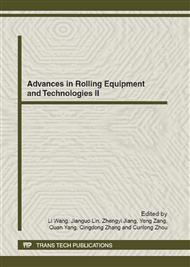p.125
p.131
p.137
p.143
p.148
p.154
p.160
p.165
p.171
Effect of Process Parameters on the Temperature of 4Cr9Si2 Martensite Refractory Steel during CWR
Abstract:
Based on the constitutive relationship of 4Cr9Si2 martensite refractory steel obtained by Gleeble-1500 hot simulation isothermal compression, a finite element model of Cross Wedge Rolling was build up for 4Cr9Si2 Martensite and the heat conduction, convection, plastic work and friction work were taken in account in the model. The forming process of 4Cr9Si2 martensite refractory steel by cross wedge rolling was simulated by means of DEFORM-3D software. The influence regularities of temperature of rolling process parameters were obtained: temperature rise rapidly result from plastic work and friction work in the cross-section at the process of rolling, with the completion of rolled piece cross-section, temperature descending due to heat conduction and radiation with atmosphere. The rolled piece temperature difference decrease with rolling speed and die preheat temperature increasing, the billet heating temperature is little for rolled piece temperature difference compared with rolling speed and die preheat temperature.
Info:
Periodical:
Pages:
148-153
Citation:
Online since:
October 2012
Authors:
Keywords:
Price:
Сopyright:
© 2012 Trans Tech Publications Ltd. All Rights Reserved
Share:
Citation:


